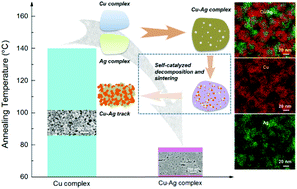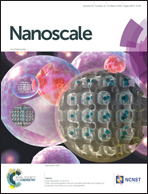Self-catalyzed copper–silver complex inks for low-cost fabrication of highly oxidation-resistant and conductive copper–silver hybrid tracks at a low temperature below 100 °C†
Abstract
Cu–Ag complex inks are developed for printing conductive tracks of low cost, high stability, and high conductivity on heat-sensitive substrates such as polyethylene terephthalate (PET) substrates. The inks show an obvious self-catalyzed characteristic due to the in situ formation of fresh metal nanoparticles which promote rapid decomposition and sintering of the inks at a low temperature below 100 °C. The temperature is 40–60 °C lower than those of general Cu complex inks and 100–120 °C lower than those of general Cu/Ag particle inks. Highly conductive Cu–Ag tracks of 2.80 × 10−5 Ω cm and 6.40 × 10−5 Ω cm have been easily realized at 100 °C and 80 °C, respectively. In addition, the printed Cu-based tracks not only show high oxidation resistance at high temperatures of up to 140 °C (the maximum tolerable temperature of current PET substrate) but also show excellent stability at high humidity of 85% because of the very uniform Cu–Ag hybrid structure. The printable tracks exhibit great potential application in various wearable devices fabricated on textiles, papers, and other heat-sensitive substrates.



 Please wait while we load your content...
Please wait while we load your content...